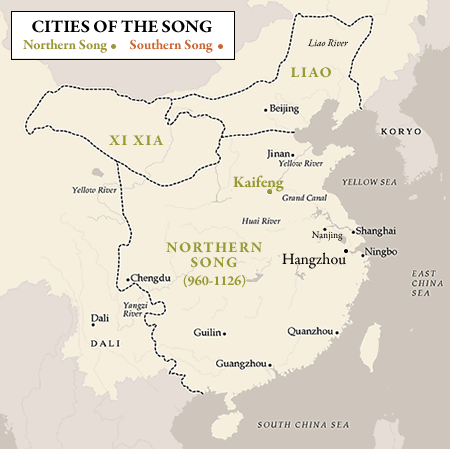The Song Dynasty in China From " Columbia University Asia for Educators .

Map showing borders of the Northern Song dynasty (960–1126) and its neighbors, the Xi Xia and Liao, with major cities in green, and the Southern Song dynasty (1127–1279) and its neighbors, the Xi Xia and Jin, with major cities. in orange.
In 1000, 1100, 1200, and 1300, China was the most advanced place in the world. Marco Polo (1254–1324) recognized this when he got to China in the late 13th century after traveling through much of Asia. In what is now Europe, this was the period now referred to as the “high” Middle Ages, which fostered the Crusades and witnessed the rise of Venice, the mercantile center that was Marco Polo’s home.
For several centuries the Chinese economy had grown spectacularly: "Between … 960 and … 1127, China passed through a phase of economic growth that was unprecedented in earlier Chinese history, perhaps in world history up to this time. It depended on a combination of commercialization, urbanization, and industrialization that has led some authorities to compare this period in Chinese history with the development of early modern Europe six centuries later." (tip: click on these buttons to see footnotes)
- During the Song Dynasty (960–1276), technology was highly advanced in fields as diverse as agriculture, iron-working, and printing. Indeed, scholars today talk of a Song economic revolution.
- The population grew rapidly during this time—from approximately 50 million in 742 to 100 million by 1100—and more and more people lived in cities.
- The Song system of government was also advanced for its time. The upper-levels of the government were staffed by highly educated scholar-officials selected through competitive written examinations.
Why else is the Song Dynasty so significant?
Many ways of living and acting that are now seen as most “Chinese,” or even characteristically East Asian, did not appear before the Song.
- Rice and tea are historically important crops/staple foods in China; but most Chinese during the previous Tang dynasty and before ate wheat and millet and drank wine. Rice and tea became dominant food and drink in the Song.
- China’s population is large, and tends to “explode” in certain periods; its first explosion occurred in the Song.
- Many Chinese are “Confucians”; but the kind of Confucianism that served as government orthodoxy throughout late-imperial times was a Song reinvention.
- Chinese women are known to have bound their feet; but they did not bind them until the Song.
- Even the “Chinese” roof with its turned-up corners is by origin a Song Chinese roof.
Yet, despite its political and economic strengths, Song China was not able to dominate its neighbors militarily. Central to its engagement with the outside world were efforts to maintain peace with its powerful northern neighbors (Liao, Jin, Xi Xia, and the Mongols) and extend its trading networks (the Silk Road and the port of Quanzhou).
